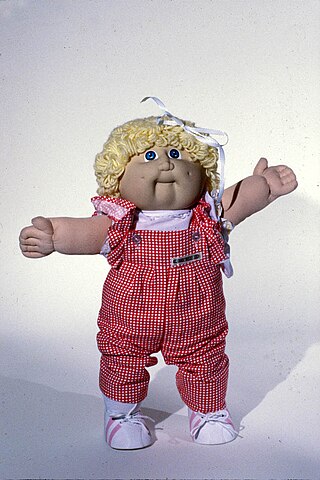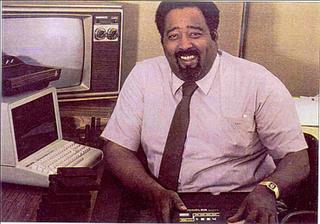
Coleco Industries, Inc. was an American company founded in 1932 by Maurice Greenberg as The Connecticut Leather Company. It was a successful toy company in the 1980s, mass-producing versions of Cabbage Patch Kids dolls and its video game consoles, the Coleco Telstar dedicated consoles and ColecoVision. While the company ceased operations in 1988 as a result of bankruptcy, the Coleco brand was revived in 2005, and remains active to this day.

Pong is a table tennis–themed twitch arcade sports video game, featuring simple two-dimensional graphics, manufactured by Atari and originally released on 29 November 1972. It was one of the earliest arcade video games; it was created by Allan Alcorn as a training exercise assigned to him by Atari co-founder Nolan Bushnell, but Bushnell and Atari co-founder Ted Dabney were surprised by the quality of Alcorn's work and decided to manufacture the game. Bushnell based the game's concept on an electronic ping-pong game included in the Magnavox Odyssey, the first home video game console. In response, Magnavox later sued Atari for patent infringement.

Cabbage Patch Kids are a line of cloth dolls with plastic heads first produced by Coleco Industries in 1982. They were inspired by the Little People soft sculptured dolls sold by Xavier Roberts as collectibles. The brand was renamed 'Cabbage Patch Kids' by Roger L. Schlaifer when he acquired the exclusive worldwide licensing rights in 1982.

A toy or plaything is an object that is used primarily to provide entertainment. Simple examples include toy blocks, board games, and dolls. Toys are often designed for use by children, although many are designed specifically for adults and pets. Toys can provide utilitarian benefits, including physical exercise, cultural awareness, or academic education. Additionally, utilitarian objects, especially those which are no longer needed for their original purpose, can be used as toys. Examples include children building a fort with empty cereal boxes and tissue paper spools, or a toddler playing with a broken TV remote control. The term "toy" can also be used to refer to utilitarian objects purchased for enjoyment rather than need, or for expensive necessities for which a large fraction of the cost represents its ability to provide enjoyment to the owner, such as luxury cars, high-end motorcycles, gaming computers, and flagship smartphones.

The Berenstain Bears is a children's literature franchise created by the late Stan and Jan Berenstain and continued by their son, Mike Berenstain, who assumed partial authorship in 2002, and full authorship in 2012 following his mother's passing. The books feature a family of anthropomorphic grizzly bears who generally learn a moral or safety-related lesson in the course of each story.

Ralph Henry Baer was a German-American inventor, game developer, and engineer.

The Strong National Museum of Play is part of The Strong in Rochester, New York, United States. Established in 1969 and initially based on the personal collection of Rochester native Margaret Woodbury Strong, the museum opened to the public in 1982, after several years of planning, cataloguing, and exhibition development for the museum's new building in downtown Rochester.

The National Toy Hall of Fame is a U.S. hall of fame that recognizes the contributions of toys and games that have sustained their popularity for many years. Criteria for induction include: icon status ; longevity ; discovery ; and innovation. Established in 1998 under the direction of Ed Sobey, it was originally housed at A. C. Gilbert's Discovery Village in Salem, Oregon, United States, but was moved to the Strong National Museum of Play in Rochester, New York, in 2002 after it outgrew its original home.

Ideal Toy Company was an American toy company founded by Morris Michtom and his wife, Rose. During the post–World War II baby boom era, Ideal became the largest doll-making company in the United States. Their most popular dolls included Betsy Wetsy, Toni, Saucy Walker, Shirley Temple, Miss Revlon, Patti Playpal, Tammy, Thumbelina, Tiny Thumbelina, and Crissy. The company is also known for selling the Rubik's Cube.

Fisher-Price, Inc. is an American company that produces educational toys for infants, toddlers and preschoolers, headquartered in East Aurora, New York. The company was founded in 1930 during the Great Depression by Herman Fisher, Irving Price, Helen Schelle, and Margaret Evans Price.

Educational toys are objects of play, generally designed for children, which are expected to stimulate learning. They are often intended to meet an educational purpose such as helping a child develop a particular skill or teaching a child about a particular subject. They often simplify, miniaturize, or even model activities and objects used by adults.

A toy museum is a museum for toys. They typically showcase toys from a particular culture or period with their history. These are distinct from children's museums, which are museums for children, and are often interactive – toy museums may be aimed at children or adults, and may have interactive exhibits or be exclusively for display.
Margaret Woodbury Strong was an American collector and philanthropist. Strong was an avid collector, especially of toys and her large collection formed the basis for the Strong National Museum of Play.

Gerald Anderson Lawson was an American electronic engineer. He is known for his work in designing the Fairchild Channel F video game console as well as leading the team that pioneered the commercial video game cartridge. He was thus dubbed the "father of the videogame cartridge" according to Black Enterprise magazine in 1982. He eventually left Fairchild and founded the game company Video-Soft.

The International Center for the History of Electronic Games (ICHEG) collects, studies, and interprets video games, other electronic games, and related materials and the ways in which electronic games are changing how people play, learn, and connect with each other, including across boundaries of culture and geography. Located at The Strong in Rochester, New York, United States, it houses one of the world's largest, most comprehensive collections of electronic game platforms, games, and related materials, with more than 37,000 items.
Entex Industries, Inc. was an American toy and electronic game manufacturer based in Compton, California. The company was active during the 1970s and 1980s.
Playthings was an American trade magazine focusing on the toy and game industry. It was founded in 1902 by editor Robert McCready and publisher Henry C. Nathan, and it was published in physical form by Sandow Media on a monthly basis until Fall 2010 when it became an insert section and was merged with Gifts & Decorative Accessories magazine. Playthings was also published online and supplemented by a weekly email newsletter, Playthings Extra. The magazine won multiple Jesse H. Neal Awards, and was generally regarded as the premier trade magazine of the American toy industry.

The World Video Game Hall of Fame is an international hall of fame for video games. The hall's administration is overseen by The Strong's International Center for the History of Electronic Games, and is located at The Strong National Museum of Play in Rochester, New York, United States. The museum began the International Center for the History of Electronic Games in 2009, announced the formation of the hall of fame in February 2015, and opened it on June 4, 2015. It is located in a dedicated part of the "ESL Digital Worlds: High Score" exhibit at the National Museum of Play; prior to an expansion of the museum in 2023 it was located in the museum's "eGameRevolution" exhibit. The Strong has also run the National Toy Hall of Fame since 2002.
George Rollie Adams, is an American educator, historian, author, and museum professional. As president and CEO of The Strong National Museum of Play in Rochester, New York, from 1987 through 2016, Adams led the development of the world’s first collections-based history museum devoted solely to the study of play and its critical role in learning and human development and the ways in which play illuminates cultural history. During his tenure, The Strong became home to the world’s most comprehensive collection of toys, dolls, board games, electronic games, and other artifacts and documents pertaining to the history of play. The Strong also acquired the National Toy Hall of Fame and established the International Center for the History of Electronic Games, World Video Game Hall of Fame, Brian Sutton-Smith Library and Archives of Play, Woodbury School, and American Journal of Play.

Barbie Fashion Designer is a dress-up computer game developed by Digital Domain and published by Mattel Media for Microsoft Windows and Mac OS in 1996. The game allows players to design clothing and style outfits. Players can then print off their designs and create clothing for their real-world Barbie dolls. Barbie Fashion Designer was the first commercially successful video game made for girls. After its success, many other girl games would be made, leading to the girls' games movement.


















